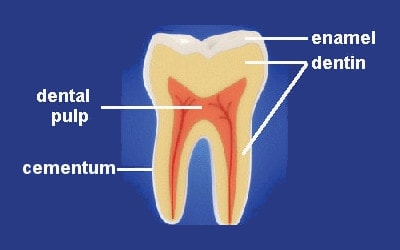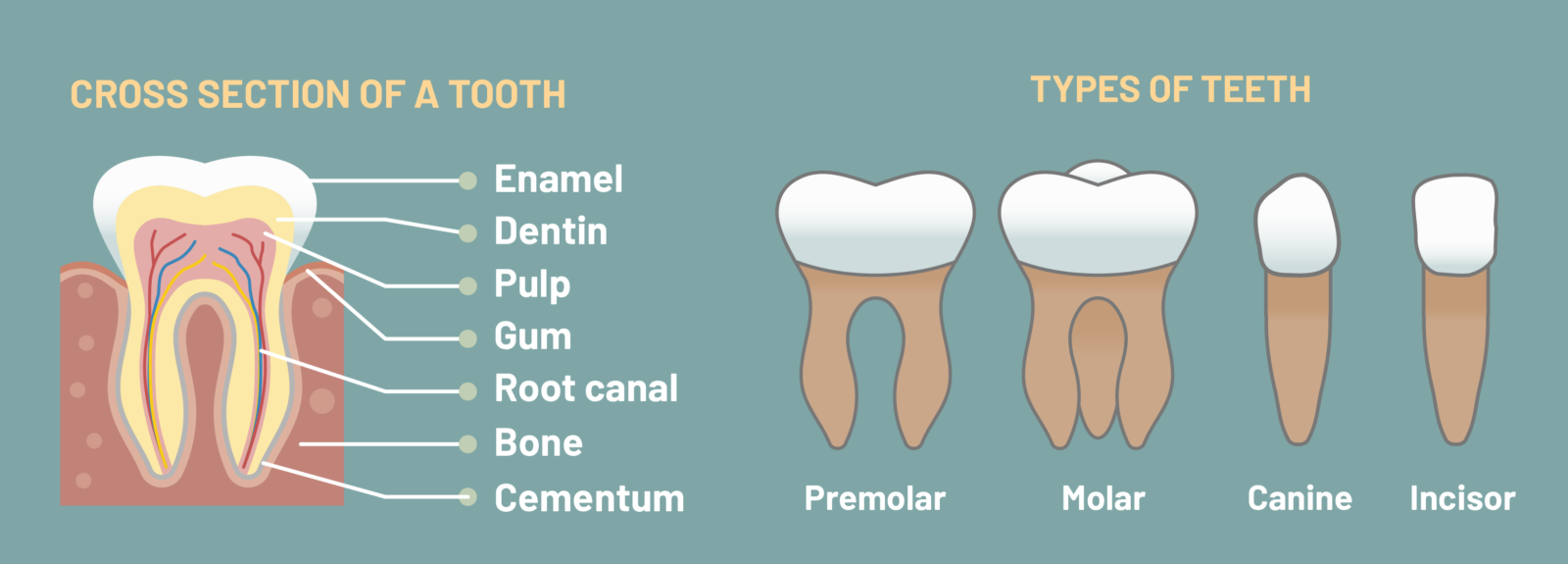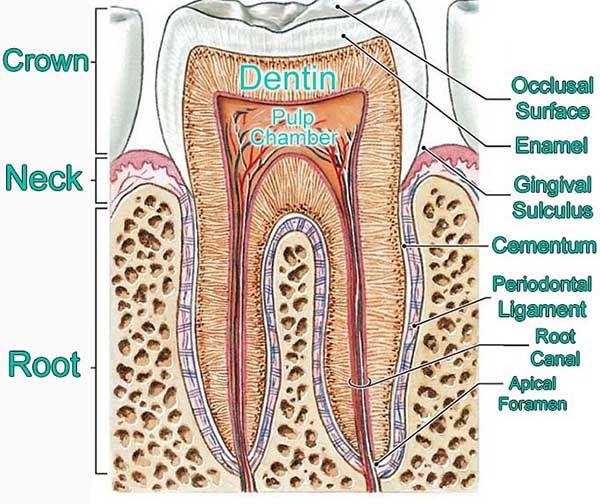Portion of the tooth embeded in bone. Cement crown neck of tooth dentin enamel a.

Discover The Structure Of Our Teeth
Narrow gap between the crown and the gum.

. How are major depression and mild depression similar. As a verb jawbone means to talk a lot often to persuade someone to cooperate. The pulp and pulp cavity which contains the blood vessels.
The dentine forms the main bulk or core of each tooth and extends almost the entire length of the tooth being covered by enamel on the crown portion and by cementum on the roots. Alveoli over the jaw bone. The crown is covered by enamel which is related to the.
Surface epithelium lamina propria muscular layer. Teeth one of the small bonelike structures of the jaws for biting and mastication of food. The cementum which covers the roots.
The term jawbone refers to the mandible when used as a noun. Each tooth consists of a crown with one or more tips cusps a neck and a root. Beneath your tooths enamel theres a bone-like tissue called dentin which makes up most of your teeths structure.
The root which is the part that extends into the jawbone. Material covering the tooth root b. The portion below is the root.
The periodontium is the supporting structure of a tooth helping to attach the tooth to surrounding tissues and to allow sensations of touch and pressure. Site of blood vessels nerves and lymphatics. It holds the teeth in place.
The middle layer of the tooth is composed of dentine which is less hard than enamel and similar in composition to bone. Cementum is light yellowish in color slightly lighter than dentin. The trabeculae may appear to be a random network but each trabecula forms along lines of stress to direct forces out to the more solid compact bone providing strength to the bone.
Root Neck and Crown. Portion of the tooth embedded in bone. Forms the major portion of tooth structure.
It is a living tissue softer than enamel with a structure similar to bone. Portion of the tooth embedded in bone. Spongy bone provides balance to the dense and heavy compact bone by making bones lighter so that muscles can move them more easily.
It is distinguished into three parts. The enamel which is the shell that covers the visible part of the tooth. The portion of a tooth that rises above the gum is the crown.
Every tooth would be hard to pull out because the teeth are embedded. The tooth is placed in a socket or alveolus plural. The pulp tissues enter the tooth from a hole at the tip.
The jaw consists of two bonesthe mandible and the maxilla. It helps to attach the tooth to the bone. The area of the tooth below the dentin.
Forms the major portion of tooth structure similar to bone g. Material covering the tooth root. The periodontium supports the teeth within the alveolar bone and consists of cementum alveolar bone and the periodontal ligaments These tissues protect and nourish the teeth.
Hardest substance in the body d enamel 4. Also it has a supporting nutritive sensory and remodeling function. Forms the major portion of tooth structure.
What portion of the tooth embeds in the bone. The major portion of an atoms mass is made up of protons and neutrons. Well they are both forms of depression and both show some of the same.
Review Sheet 38 87 Key. Its susceptible to the bacteria that cause tooth sensitivity and cavities. Each tooth is paired within the same jaw while the opposing jaw has teeth that are classified within the same category.
It consists of the cementum periodontal ligaments alveolar bone and gingiva. The jaw bone also called the alveolar bone is the bone that contains the tooth sockets and surrounds the teeths roots. Attaches the tooth to the socket.
Site of blood vessels nerves and lymphatics. They are seated within the upper and lower alveolar bone in the maxilla and mandible respectively and this exclusive type of joint is known as gomphosis. Dentine forms the major component of each tooth and extends almost the entire length of the tooth.
Its a bone-like structure that surrounds the root of your tooth. The dental pulp also called the nerve of the tooth is the central part of the tooth and is filled with soft connective tissue that contains blood vessels and nerves. Portion of the tooth in bone socket.
Portion of the tooth embedded in bone odontoblast 6. The lower teeth are anchored into the mandible and the upper teeth are in the maxilla. Site of blood vessels nerves and lymphatics of the tooth.
Area between the teeth and lipscheeks. Forms the major portion of tooth structure. The periodontal ligament provides an attachment of the tooth to the jaw bone.
The clinical crown is that part of the tooth exposed in the oral cavity. Of these cementum is the only one that is a part of a tooth. What forms the major portion of tooth structure similar to bone.
Forms the major portion of tooth structure. It is sensitive and is protected by enamel on the crown portion and cementum on the roots. Cementum is the outer layer of the tooth structure for the root part of the tooth which lies under the gum line.
Attaches the tooth to the tooth socket e. They also help in the shaping of sounds and forming of words in speech. Visible portion of the tooth above the gum.
Absorbs water and forms feces. It is connective tissue fibers in the small gap between the cementum and the jaw bone. It is also known as periodontal fibers.
Cementum is present in the next layer. In contrast to the brittle nature of enamel dentine is elastic and compressible. Structure of a tooth.
Entire portion of the tooth covered with enamel. Visible portion of the tooth in situ 2. However they are not grouped according to structure but rather by function.
The dentin a bone-like substance which makes up most of the tooth. It is a bonelike material almost as hard as enamel but with a less inorganic composition. Along the border between the dentin and the pulp are odontoblasts which initiate the formation of dentin.

Dentin And The Components Of Your Teeth Signature Smile



0 Comments